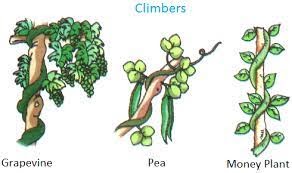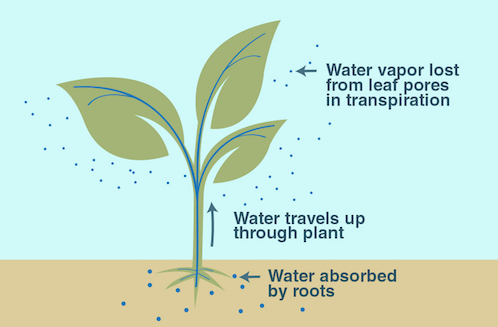GETTING TO KNOW PLANTS for Class 6 SCIENCE
Introduction
Jaise ki chapter ka name hai Getting to know plants toh iss chapter mein hum apne aas-paas present plants ke baare mein padhenge. Iss chapter mein hum chote, bade sabhi plants ke bare mein study karenge. Hum yaha herbs, shrubs, trees, creepers, climbers, plant ke sabhi parts, unke reproductive parts, etc. ke bare mein study karenge. Yaha hum transpiration aur photosynthesis ke process ko bhi janege.
Herbs, Shrubs And Trees
Sabhi plants ki different height aur characteristics hote hai. Inn characteristics ke basis par hum plants ko herbs, shrubs aur trees mein classify karte hai.
Herbs: Aise plants jinki green aur tender stem hoti hai unko herbs kehte hai. Inki height usually short hoti hai aur inki branches bhi bahut kum hoti hai. Yeh sabse smallest plants hote hai. Eg- Wheat, Paddy (Rice), Cabbage,Tomato, etc.

Shrubs: Yeh aise plants hote hai jo bushy hote hai, inki stems hard hoti hai aur yeh easily bend nahi hote. Aise plants ki branches stem ke base se hi develop hona start kar deti hai. Yeh herbs se bade hote hai. Eg- Lemon, Tulsi, Rose, Jasmine (Chameli), Bougainvillea, etc.

Trees: Yeh big aur largest plants hote hai. Inki tall aur strong stem hoti hai. Iski stem ko hum trunk kehte hai. Iski branches ground se bahut upar stem ke upper part se arise hoti hai. Eg- Mango, Neem, Banyan (Peepal), jamun, Peepal, Coconut, Teak, etc.

Lekin apni daily life mein toh hum kuchh aise plants bhi dekhte hai jo inse different characteristics show karte hai e.g- Money plant, grape vines, beanstalk, etc. Toh yeh plants kis category mein aate hai?
Yeh climbers aur creepers ki category mein aate hai. Ab hum inki characteristics ke bare mein padhenge.
Climbers: Inki stems weak hoti hai isliye yeh sidhe khade nahi ho sakte. Yeh other trees ya other things ka support lekar climb karte hai. Eg- Sweet gourd (petha), Bitter gourd (Karela), Bottle ground (Lauki), etc.

Creepers: Aise plants jo sidhe khade nahi ho sakte aur ground par spread hote hai unko creepers kehte hai. Eg- Pumpkin plant, watermelon plant and muskmelon plant.

POINT 1
Herbs: Herbs are small plants having a soft and delicate stem.
Shrubs: Shrubs are medium-sized plants with a hard woody stem, branching out near the base.
Trees: Trees are tall and big plants with hard and thick woody stem.
Climbers: A Plant having thin, long and weak stem which cannot stand upright but rapidly climbs up a neighbouring support (like a fence) or a tree is called a climber.
Creepers: A plant having thin, long and weak stem which cannot stand upright and spreads on the ground, is called a creeper.
Parts of plant
Ab hum niche di hui picture mein plants parts ke name jante hai aur fir aage inn parts ke bare mein detail mein padhenge.

Stem
Leaf
Plants mein green colour ki leaves present hoti hai. Yeh different shape aur size ki hoti hai. Leaf mein bhi different parts present hote hai jaise- petiole, veins, lamina, etc. Yeh sabhi hum niche figure mein dekh sakte hai.

Ab hum inn parts ke baare mein janege.
Petiole: Leaf ka aisa part jisse wo stem se attach hota hai usko hum petiole kehte hai.
Lamina: Leaf ke broad green part ko hum lamina kehte hai.
Veins: Leaves par jo thread like structures present hote hai unko veins kehte hai.
Midrib: Leaf ke middle mein jo main vein present hoti hai usko hum midrib kehte hai.
Leaf venation: Veins leaf mein jo design (pattern) bana deti hai usko leaf venation kehte hai.
Leaf venations do type ki hoti hai.
Parallel venation: Agar leaf par veins parallel pattern mein present hai to wo parallel venation hota hai. Grains, Musa, Grass, etc. kuchh aise plants hai jinki leaves mein parallel venation dekha jata hai.

Hamne leaf ke structure ke baare mein toh jaan liya lekin ab hum dekhenge ki leaf kya functions karti hai?
Plant mein leaves ka bahut important function hai kyonki plant mein transpiration aur photosynthesis dono hi process leaves mein hote hai. Ab hum transpiration aur photosynthesis ke bare mein padhenge.
Transpiration: Leaves se water loss hone ke process ko transpiration kehte hai. Yeh water, vapours ki form mein leaves se stomata ke through nikalta hai. Stomata leaves par present tiny pores hote hai. Plants transpiration ke process se bahut sara water air mein release karte hai.

Photosynthesis: Yeh ek aisa process hai jisme plants carbon dioxide, water, sunlight aur chlorophyll ko use karke apna food banate hai. Yeh process leaf mein hota hai kyonki green leaves mein chlorophyll present hota hai. Photosynthesis ke process mein oxygen release hota hai aur jo food prepare hota hai wo plants ke different parts mein store hota hai.

Hamne abhi padha ki water stem ke through leaves tak jata hai lekin stem ke paas water kaha se ata hai?
Stem ke paas water roots se ata hai. Ab hum iske baare mein detail mein jante hai.
POINT 2
Stem: The stem is the portion of the plant that sits above the ground.
Leaf: The leaf is a thin, broad, flat and green part of a plant which is attached to the stem or branch.
Petiole: The part of leaf by which it is attached to the stem is called petiole.
Lamina: The broad green part of leaf is called lamina.
Vein: Small lines present on a leaf are called its vein.
Midrib: The thick vein in the middle of the leaf is called the midrib.
Parallel venation: If the design made by veins is parallel to one another in a leaf is called parallel venation.
Reticulate venation: Reticulate venation refers to the arrangement of veins in a leaf where they form a web-like structure.
Transpiration: The loss of water from plants as water vapour through the pores of their leaves is called transpiration.
Photosynthesis: Photosynthesis is the process by which plants prepare their own food using carbon dioxide and water in the presence of sunlight.
Root
Root plant ka aisa part hai jo underground hota hai. Yeh ground ke niche soil mein grow karti hai. Roots soil mein se water aur minerals absorb karti hai aur yeh plant ko firmly soil mein hold karne mein help karti hai. Kuchh aise plants bhi hai jo apna food roots mein store karte hai. Aise plants ke example dekhte hai jinki roots ko hum khate hai- carrot, radish, sweet potato, turnip, tapioca, etc.
Roots do types ke hote hai-

Taproot: Kuchh plants mein roots ke branches ek main thick root se nikalte hai. Aise roots ko hum taproots bolte hai. Main thick root ko hum primary root kehte hai aur uske branches ko hum lateral roots kehte hai. Eg- Beetroot, carrot, parsley, etc.
Fibrous root: Kuchh plants mein roots ke branches stem ke base se nikalte hai, aise roots ko fibrous roots kaha jata hai. Inki koi main root nahi hoti, sabhi roots similar hoti hai. Eg- Grasses such as wheat, rice, corn etc.
Ab hum plant ke ek aur part flower ke bare mein padhenge.
Flower
Hamne apne aas-paas bahut sare flowers dekhe honge jaise rose, sunflower, china rose, etc. Ab iss topic mein hum flower ke parts ke bare mein detail mein padhenge.
Flower plant ka reproductive part hota hai aur yeh coloured hota hai isliye sabse jyada attractive hota hai.
Ab hum flower ke parts ke bare mein padhenge. Iske parts hai- Sepals, petals, stamen, pistil.

Sepals: Sepals flower ki sabse outer covering hoti hai. Yeh small green leaf-like structures hote hai aur flower ki outer covering ko protect karte hai.
Petals: Flower ka jo coloured part hota hai usko petals kehte hai. Yeh sepals ke andar ki side attach hota hai. Iski ek sweet smell hoti hai jisse insects aur birds flowers ki taraf attract hote hai.
Different flowers ke different colours hote hai aur different number of sepals and petals hote hai. Eg- 5 different colours ke roses paaye jaate hai, isme five sepals hote hai aur 5 petals hote hai.
Stamen: Yeh flower ka male reproductive part hota hai. Iske do parts hote hai-
(a) Anther
(b) Filament
Anther ke andar pollen grains present hote hai.

Pistil: Flower ka innermost part pistil hota hai. Pistil ko hum carpel bhi kehte hai. Stamens ko remove karke hum pistil ko dekh paate hai.
Pistil ke 3 part hote hai-
(a)Stigma
(b)style and
(c)ovary

Ovary ko agar hum transverse ya longitudinally cut karke dekhenge toh uske andar hamein ek bead like structure dikhega jisko hum ovules kehte hai.
Flower ke reproductive parts ki details hum higher classes mein padhenge.
POINT 3
Root: The part of the plant which is below the ground (in the soil), is called root.
Taproot: The root system in which a single root arises from the base of the stem, with secondary and tertiary branches is called a taproot.
Fibrous root: In the plants like grass, the branches of the root come out from the base of the stem. Such roots are known as fibrous roots.
Flower: A flower is the reproductive part of a plant.
Sepals: The green, leaf like parts in the outermost circle of a flower are called sepals.
Petals: The colored part of flower that covers the reproductive part of flower.
Pistil: This flask shaped organ of a flower is called pistil. The pistil is the female part of a flower.
Stigma: The top part of a pistol is called stigma.
Style: The middle part of a pistil is called style.
Ovary: The swollen part at the bottom of the pistil is called ovary.
Stamen: The stamen is the male part of a flower.
Anther: The swollen top of stamen is called anther.
Filament: The stalk of stamen is called filament.
Pollen grains: The anther contains a yellow powder like substance called Pollen grains.
IMPORTANT DIFFERENCE


SUMMARY
1. Plants are usually grouped into herbs, shrubs and trees based on their height, nature of stem and branches.
2. The stem bears leaves, flowers and fruits.
3. Leaf usually has a petiole and lamina.
4. The pattern of veins on the leaf is called venation. It can be reticulate or parallel.
5. Leaves give out water vapour through the process of transpiration.
6. Green leaves make their food by the process of photosynthesis using carbon dioxide and water in the presence of sunlight.
7. Roots absorb water and minerals from the soil. They also anchor the plant firmly in the soil.
8. Roots are mainly of two types: tap root and fibrous root.
9. Plants having leaves with reticulate venation have tap roots while plants having leaves with parallel venation have fibrous roots.
10. The stem conducts water from roots to the leaves (and other parts) and food from leaves to other parts of the plant.
11. The parts of a flower are sepals, petals, stamens and pistil.